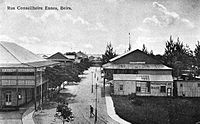
Beira, Mozambique
Background Information
This selection is made for schools by a children's charity read more. SOS Children works in 45 African countries; can you help a child in Africa?
| Beira | |
|---|---|
|
|
|
| Coordinates: 19°50′S 34°51′E | |
| Country | |
| Provinces | Sofala Province |
| Government | |
| • Mayor | Daviz Simango |
| Population (2007) | |
| • Total | 436 240 |
Beira is the second largest city in Mozambique. It lies in the central region of the country in Sofala Province, where the Pungue River meets the Indian Ocean. It had a population of 412,588 in 1997 and an estimated 546,000 in 2006. It holds the regionally-significant Port of Beira which acts as a gateway for both the central interior portion of the country as well as the land-locked nations of Zimbabwe, Zambia and Malawi. Beira was originally developed by the Portuguese Mozambique Company in the 19th century, and directly developed by the Portuguese colonial government from 1947 to 1975, when Mozambique gained its independence from Portugal.
History
Portuguese rule
The city was established in 1890 by the Portuguese and soon supplanted Sofala as the main port in the Portuguese-administered territory. Originally called Chiveve, after a local river, it was re-named to honour the Portuguese Crown prince Dom Luís Filipe who, in 1907, was the first member of the Portuguese royal family to visit Mozambique. Traditionally the Portuguese Crown prince carried the title of Prince of Beira, a historical province of mainland Portugal. The Portuguese built the port and a railway to Rhodesia, Portuguese families settled in the newly-founded locality and started to develop commercial activities. With the growth of the village, in 1907 the Portuguese Crown elevated Beira to the status of city (cidade). Since 1891 as the headquarters of the Companhia de Moçambique ( Mozambique Company), the city's administration passed from the trading company to the Portuguese government in 1942. In 1966, the construction of a new railway station was completed. Before Mozambique's independence from Portugal, as a city of Portuguese Mozambique, Beira was noted for its well-equipped seaport, one of the major facilities of its kind in all East Africa, tourism, fishing and trade. The city prospered as a cosmopolitan port with different ethnic communities (Portuguese, Indian, Chinese, indigenous Africans) employed in administration, commerce, and industry. A large English-speaking population was the result of being a favourite holiday destination for white Rhodesians. One reminder of this is the Grande Hotel, built by the Portuguese, near the shore of the Indian Ocean. By 1970, the city of Beira had 113,770 inhabitants.
After independence from Portugal
After independence from Portugal in 1975, many white ethnic Portuguese left the city. Mozambique was ravaged by a civil war from 1977 to 1992, opposing Marxist FRELIMO, which controlled the government, to the rebels of RENAMO, descending to near total chaos in a couple of years. The famine, disease and poverty-stricken country collapsed. In the city of Beira, its famous Grande Hotel was occupied by around 1,000 homeless Beirans, and by the end of the civil war it was in near-ruins.
The 2000 Mozambique flood devastated Beira and the surrounding region, leaving millions homeless and severely damaging the local economy.
Demographics
| Year | Population |
|---|---|
| 1970 | 113 770 |
| 1980 | 230 744 |
| 1997 | 412 588 |
| 2007 | 436 240 |
Tourism
Tourism is a potential industry for Beira, but returns are limited. Potential tourist attractions include the cathedral, lighthouse, Macuti Beach and the Grande Hotel Beira. North of the city is the former Gorongosa national park.There are few restaurants or hotels of a tourist standard and security is poor in some areas.
Transportation
Beira has long been a major trade point for exports coming in and out of Zimbabwe, Malawi, Zambia and other Southern African nations. Because of this, the port of Beira is the second largest in Mozambique. The importance of the port was shown during the Mozambique Civil War, when Zimbabwean troops protected the railway and highway from Beira to Mutare in order to continue trade.
The railway to Zimbabwe was originally 610 mm (2 ft) in 1890, but was converted to 1,067 mm (3 ft 6 in) in 1900.
Recently, the Mozambique transportation minister, Paulo Zucula, stated that the government is planning on modernizing the Beira and more northern Nacala ports for an estimated cost of $900m; $500m and 400m respectively. The government has also stated that it plans on modernizing surrounding railway and highway infrastructure so that the port is better connected to the nation's mines.
There is also a ferry service in Beira, linking the city to neighboring cities, including Nova Sofala and other coastal towns. Beira is served by an airport to the northeast of the city, with both domestic and international flights.
International relations
Twin towns — Sister cities
Beira is twinned with:
In the past, Beira also been twinned with Amsterdam, Netherlands (until 2005)
Famous persons born in Beira
- Mia Couto (* 1955) writer
- Pedro Boese (* 1972) artist
- Carlos Cardoso (* 1951) ( † 22 November 2000, Maputo) journalist
- Tasha de Vasconcelos (* 1966) actress, top model
- João Luis Sol de Carvalho (* 1953) writer, film director



